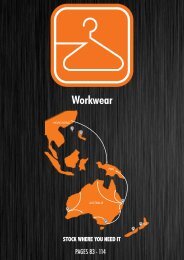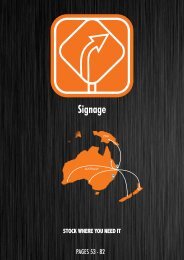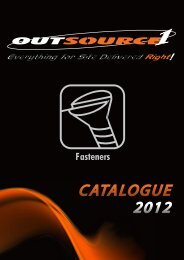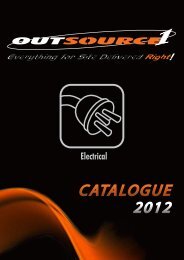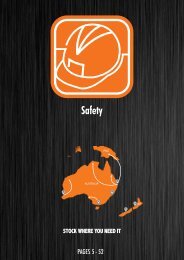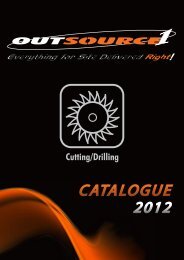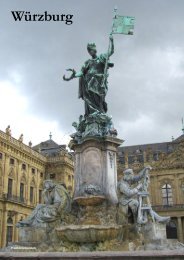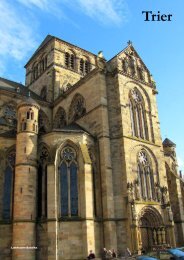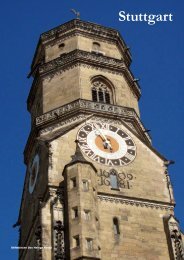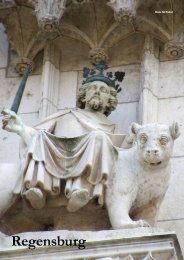Raven Guides: Germany - Nuremberg
You also want an ePaper? Increase the reach of your titles
YUMPU automatically turns print PDFs into web optimized ePapers that Google loves.
The main basilica of the high Gothic St-Lorenz-Kirche<br />
in Königstraße, partly modelled on St Sebald, was built<br />
between 1270 and 1390, with grand portal, rose window<br />
and flying buttresses. Chapels for the patrician families<br />
came to be added during the next century, followed by a<br />
High Gothic choir and chancel. A Baroque altar was<br />
added in the 18th and 19th centuries, but the shrine from<br />
an altar raised in 1437 to the relics of the Carolingian<br />
abbot Deocarus was destroyed in 1811. The scene of the<br />
Annunciation (Engelsgruß, 1518) hanging near the centre<br />
of the church and the main altar crucifix (1520) are by<br />
Veit Stoß, the tabernacle (1496) by Adam Krafft. The<br />
church is open M-Sa 9-17, Su 12-16 and a contribution of<br />
€1 is requested. Take U1 or U11 to Lorenz-Kirche.<br />
The distinctive Pegnitz<br />
bridges are the<br />
Renaissance<br />
Fleischbrücke (1598),<br />
the western of the two<br />
Pegnitz crossings the<br />
below the Hauptmarkt,<br />
and the roofed wooden<br />
Henkersteg<br />
(originally 1457),<br />
named for the<br />
executioner who lived<br />
in an adjacent house.<br />
Fleischbrücke, which<br />
replaced two earlier<br />
bridges, was patterned<br />
on Venice’s Rialto<br />
bridge and built on<br />
more than 2000<br />
wooden piles.<br />
Henkersteg now links<br />
the water tower and<br />
Weinstadel (1448),<br />
originally a leper<br />
house given over to<br />
wine storage, with the<br />
Unschlitthaus (former<br />
tallow house). Take<br />
bus 36 to Hauptmarkt<br />
or Weintraubengasse.<br />
Museumsbrücke near Hauptmarkt gives the best<br />
view of the extraordinary protruding wing of<br />
the infirmary Heilig-Geist-Spital (1339), later<br />
built out over the Pegnitz by master stonemason<br />
Hans Beheim, who finally completed the labour<br />
in 1527. The foundation and its adjoining church<br />
were destroyed in World War II but the spital<br />
and belfry tower were rebuilt. The<br />
Kreuzigungshof courtyard of the complex with<br />
a crucifixion by Adam Krafft can be reached<br />
through the east portal near Spitalbrücke (open<br />
to 18.00 – climb the steps directly ahead on<br />
entering). Take bus 36 to Hauptmarkt or U1 or<br />
U11 to Lorenz-Kirche.<br />
The site of the Frauenkirche (1361) at Hauptmarkt<br />
was occupied by the synagogue before the pogrom of<br />
1349. This history is belied today by the noon daily<br />
clock parade of the Männleinlaufen (1509), toddling<br />
figures representing the emperor Charles IV and the<br />
electors of the Holy Roman empire – recognition of<br />
the city’s place as the venue of the first imperial<br />
assembly in 1356. Acknowledgement of the site’s<br />
darker past is in a plaque on the north side of the<br />
church and a star of David in the choir. Among the<br />
treasures inside are statues from the 14th century and<br />
the 15th century Tucher altar. Take bus 36 to<br />
Hauptmarkt.<br />
Views<br />
The open Burgfreiung area before the gates to<br />
the Kaiserburg provides a rooftop view south<br />
over the Altstadt, but the observation platform<br />
of the tower Sinwellturm (€3.50/2.50) offers<br />
the complete <strong>Nuremberg</strong> panorama.<br />
Parks & gardens<br />
The Stadtpark strings out along Bayreuther<br />
Straße just north-east of the Altstadt in<br />
Maxfeld. However the biggest city green<br />
space is the Wöhrder Wiese along the south<br />
bank of the Pegnitz, directly to the east of<br />
the Altstadt, opening into the Wöhrder See,<br />
comprising about a 2km length of the Pegnitz<br />
lined by walking paths.<br />
Volkspark Dutzendteich south-east of the<br />
city includes two lakes surrounded by open<br />
parkland. Take tram 6 to Dutzendteich.<br />
The large zoo Tiergarten Nürnberg at<br />
Am Tiergarten 30 (late Mar-early Oct M-Su<br />
8-19.30, early Oct-late Mar M-Su 9-17,<br />
€13.50/6.50) includes a dolphin lagoon,<br />
aquatic area for Arctic species and a tropical<br />
area. Take tram 5 to the terminus.<br />
Markets<br />
Fresh produce markets (M-Sa) are held at<br />
Hauptmarkt in a continuing tradition, only<br />
making way at Christmas, Easter or late<br />
September by moving to Lorenzer Platz or<br />
surrounding pedestrian streets.<br />
From late November to just before<br />
Christmas wooden stalls selling decorations,<br />
seasonal confections and gifts fill Hauptmarkt<br />
for the Christkindlesmarkt. This is one of<br />
the great Christmas markets in a country<br />
devoted to them, opened by the Christkind, a<br />
girl who proclaims the market from high on<br />
the Frauenkirche. The stalls are busy (M-Su<br />
10-21, Christmas Eve 10-14) for more than<br />
three weeks and the square is ablaze with<br />
light at night. Hot punch is available at a giant<br />
cauldron by the square.<br />
Around Easter the Ostermarkt takes over<br />
Hauptmarkt for 2½ weeks (M-Sa 9.30-19, Su<br />
10.30-19, closed Good Friday) with household<br />
wares as well as Easter fare. For a similar<br />
period on the same site in the second half of<br />
September the Herbstmarkt is a festival of<br />
Franconian food, domestic wares and art.<br />
Events<br />
City fairs are popular. A three-week<br />
Frühlingsfest (late in April and early in May,<br />
from early afternoon M-Sa, from 10.30 Su)<br />
and a two-week Herbstfest (end of August<br />
to mid September) take place at Volkspark<br />
Dutzendteich.<br />
The Spielwarenmesse (<strong>Nuremberg</strong> Toy<br />
Fair) late in January and early in February at<br />
the Messezentrum brings the world industry to<br />
the city but only trade visitors may attend.<br />
Food<br />
Lebkuchen, a regional recipe for gingerbread,<br />
is always prominent at festival times.<br />
Nürnberger Rostbratwurst, the oldest<br />
(14th century) recorded of the Franconian<br />
sausage varieties, today is presented as a<br />
short chopped-pork sausage, seasoned with<br />
marjoram and best enjoyed grilled over a<br />
flame. A trio served in a roll (locally Weckla)<br />
with mustard is the popular city street food.<br />
The sign ‘3 im Weckla’ is common with a<br />
price usually between €2.20 and €2.50.<br />
Otherwise, several bratwurst on a plate with<br />
<strong>Nuremberg</strong> 6 - RAVEN TRAVEL GUIDES GERMANY






